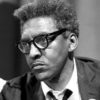
In this lesson, students will analyze the purpose of the Briggs Initiative (Prop 6), which was on the California general election ballot in 1978. The referendum sought to ban gays and lesbians, and potentially supporters of gays and lesbians, from working in California’s public schools. Then, students will evaluate voices of those opposed to the initiative by reading posters and flyers. Harvey Milk, the first openly gay elected official, was a key political figure that led the debate against people like Senator John Briggs and Anita Bryant. Additionally, the Briggs Initiative was challenged by other marginalized groups including African Americans, feminists, and unionists. Finally, students will conduct a close reading of Harvey Milk’s speech given after the defeat of the Briggs Initiative on June 25, 1978 at California’s Gay Freedom Day.
The lesson may take 90-120 minutes depending on the reading level of students and the language support needed. To divide the lesson into two days, it is suggested that the close read be done on day 2.






